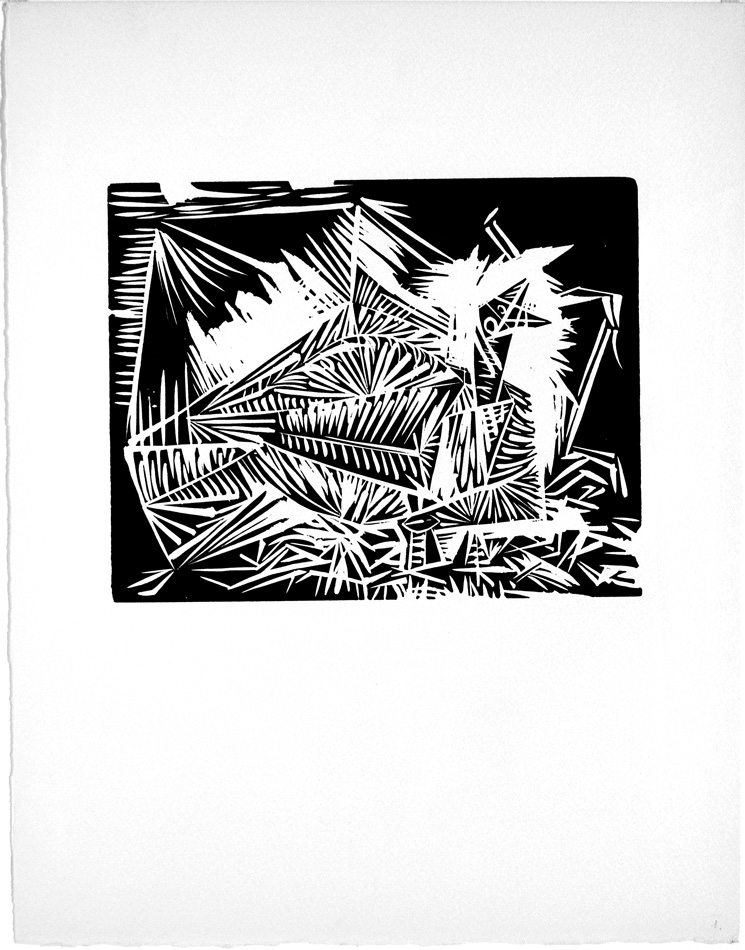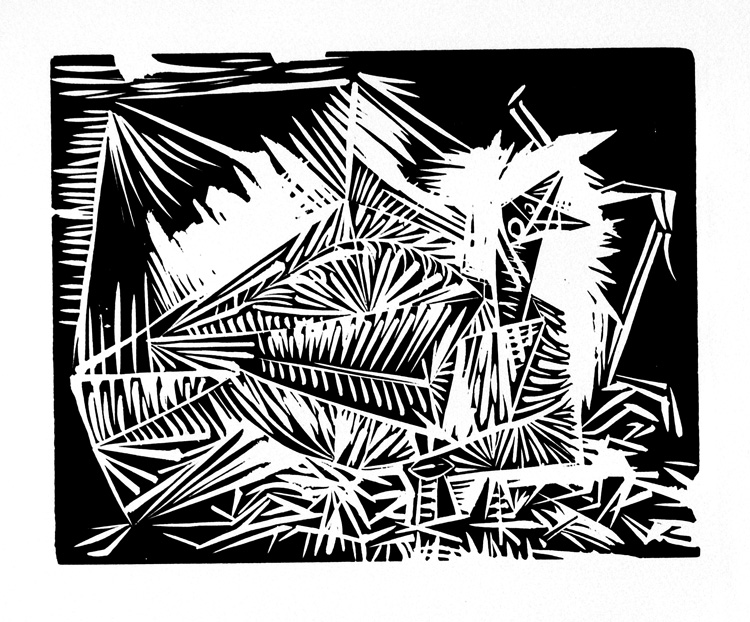Click image for BBB rating
See our Privacy Policy
cool="cool" width="785" height="5021" border="0" cellpadding="0" cellspacing="0" gridx="16" showgridx="showgridx" usegridx="usegridx" gridy="16" showgridy="showgridy" usegridy="usegridy" bgcolor="#99ccff">
|
|
|
 |
|
|
|
|
|
|
Welcome to Spaightwood Galleries, Inc.
120 Main Street, Upton MA 01568-6193
Picasso as Printmaker: Pablo Picasso: The Artist and the Book: Buffon's Histoire Naturelle.
|
|
|
|
According to Riva Castleman's Prints of the Twentieth Century (NY: Museum of Modern Art, 1976), "Some of the most significant prints of the twentieth century were made to illustrate books. This is particularly the case in Paris, where the livre illustre or livre du peintre was developed into an important form. . . . As the illustrated book evolved in the late 1920s, its pictorial matter became more conspicuous. Extra suites of plates were added to special copies of the books and many found their separate ways into the single print market. One could not have a thorough understanding of the prints of Picasso, Chagall, or Rouault [one might add Matisse, Miro, and Tapies as well] without consulting those made as book illustrations. It would be impossible to study the printed works of the Fauves and the Cubists, much less those of the Surrealists, without delving into these special books" (11-12). As Castleman, for many years curator and prints and drawings at MoMA, observed, deluxe illustrated editions were a way of exposing the artists who made them to a larger audience and doing so in an affordable and "important" way: the prints achieved more "gravitas" from their presentation in a deluxe volume and thus helped create a wider market for individually-published prints. They also served to introduce audiences to the paintings and drawings of theor creators either generally by evoking an interest in a given artists or, more particularly, by prints produced through the pochoir (stencil) technique in which painted works could be reinterpreted on a much smaller scale and presenteded with the loose pages of an unbound book for extraction and study.
Picasso, like Miro, Matisse, Chagall, and Rouault, was an assiduous creator of prints for many livres du peintre. A case in point: the etchings illustrated below made for Buffon's Histoire Naturelle and the linocut that was published as a result of Picasso's fascination with his own work. In 1936, Vollard commissioned Picasso for a suite of etchings to illustrate texts from the Count of Buffon's eighteenth-century text (published in 44 volumes!). Picasso, whom the printer Roger Lacouriere, had just introduced to the technique of lift-ground aquatint (which involves coating a copper plate with a sugar-water solution, working the plate with aquatint, and then soaking the plate to dissolve the sugar ground and lighten the surface of the plate) was eager to test out this new printing method, which enables the artist to work in a much wider range of grays between etchings's black and white, and produced 32 plates between 1936 and 1937. The plates were printed in 1937, but after Vollard's death in an automobile accident in 1939, they remained unpublished until Vollard's associate, Martin Fabiani, brought them out in 1942. The portfolio was published in an edition of 226 copies (including 36 copies on various papers containing a separate suite of the prints with remarques, 55 copies on Montval wove, and 135 copies on Vidalon wove watermarked "Ambroise" or "Vollard." Our impressions are on Vidalon. The work has been called one of the masterpieces of the twentieth century and was included in the 1960 Boston Museum of Fine Arts exhibition and catalogue, The Artist & the Book 1860-1960 and is catalogued as number 231: "It appears the artist executed them rapidly, and with the utmost freedom. . . . The spontaneity of the plates is attested by the freehand margins, the rapidly drawn line, aand the use of finger[prints for textural variety" (157-58). In 1957, another publisher, brought out a folio containing the drawings that Picasso made in 1942 in the margins of the copy of the Buffon that he had given to his mistress Dora Maar. To this work, Picasso contributed another work done about this time, a linocut, Le Pigeonneau, generally thought to be either his first or his second effort in this new technique, also illustrated below.
|
|
|
|
 |
|
|
|
Le boeuf / The ox (B. 330). Original sugar-lift aquatint, 1936. 226 portfolios, of which 36 contain an additional suite of favorite subjects from one of his most important early works, the Buffon portfolio first published in 1942 as Eaux-fortes pour Buffon / Etchings for Buffon. Picasso actually cheated here: he titled this plate Le taureau / The bull even though it was to illustrate Buffon's texts for the ox. Picasso then titled the bull Le toro espagnol. The Museum of Fine Arts, Boston, has reproduced this work as a post-card. Image size: 360x280mm. Price: Please call or email for current pricing information.
|
|
|
|
 |
|
Le vautour / The vulture (B. 341). Original sugar-lift aquatint, 1936. 226 portfolios, of which 36 contain an additional suite of favorite subjects from one of the important early works, the Buffon portfolio first published in 1942. Image size: 360x280mm. Price: Please call or email for current pricing information.
|
|
|
|
|
|
|
|
 |
|
|
Le pigeonneau (B. 326, Cramer 84). Original linogravure, c. 1939. Each of the 226 copies of the deluxe edition of 40 Dessins de Picasso en Marge du Buffon (first published in 1957) contained a signed impression of this print. Since our impression is unsigned, it must be either a trial proof or come from one of the H.C. copies of the book. An important print! Sheet size: 358x277. Image size: 155x200mm. Price: Please call or email for current pricing information.
|
|
|
 |
|
|
Le pigeonneau (B. 326, Cramer 84). Original linogravure, c. 1939. Each of the 226 copies of the deluxe edition of 40 Dessins de Picasso en Marge du Buffon (first published in 1957) contained a signed impression of this print. Since our impression is unsigned, it must be either a trial proof or come from one of the H.C. copies of the book. An important print! Image size: 155x200mm. Price: Please call or email for current pricing information.
|
|
|
 |
|
|
Le papillon (B. 350). 226 portfolios, of which 36 contain an additional suite of favorite subjects from one of the important early works, the Buffon portfolio first published in 1942. Image size: 280x218mm. Price: SOLD.
|
|
|
|
|
 |
|
L'Araignée (B. 353). Original sugar-lift aquatint, 1936. 226 portfolios, of which 36 contain an additional suite of of aquatints. One of Picasso's favorite subjects from one of the important early works, the Buffon portfolio first published in 1942. Image size: 360x280mm. Price: SOLD.
|
|
|
|
Spaightwood Galleries, Inc.
To purchase, call us at 1-800-809-3343 (1-508-529-2511 in Upton MA & vicinity) or send an email to spaightwood@gmail.com.
We accept AmericanExpress, DiscoverCard, MasterCard, and Visa.
We also accept wire transfers and paypal.
For directions and visiting information, please call. We are, of course, always available over the web and by telephone (see above for contact information). Click the following for links to past shows and artists. For a visual tour of the gallery, please click here. For information about Andy Weiner and Sonja Hansard-Weiner, please click here. For a list of special offers currently available, see Specials.
All works are sold with an unconditional guarantee of authenticity (as described in our website listing).
Copyright 2004-2017, Spaightwood Galleries, Inc.
Go back to the top of this page.
Visiting hours: Saturday 10:00 am to 5:00 pm and Sunday noon to 6:00 pm and other times by arrangement.
Please call to confirm your visit. Browsers and guests are welcome.
|
|
|
|
|
|
|
|
|
|
|
|
|
|
|
|
|
|
|
|
|
|
|
|
|
|
|
|
|
|





